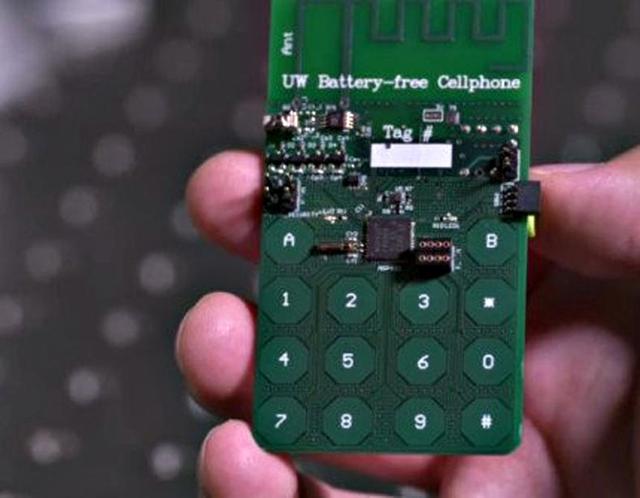(单词翻译:单击)
听力文本
This is Scientific American — 60-Second Science. I'm Christopher Intagliata.
A dying battery is a huge annoyance for cell phone users. But for engineers? It's inspiration. "Can we design a smartphone which can make a phone call and have a conversation without the need for any kind of battery?"
Shyam Gollakota is a computer scientist at the University of Washington. And he and his team have indeed designed a battery-free phone. It looks like a circuit board, with touch-responsive numeric buttons. And it runs on just a few microwatts of power, which it harvests from light, and from the radio signals emanating from a nearby wireless base station.
The team achieved the battery-free, energy-efficient design by ditching two of power-hungry features of modern cell phones. One, the test unit skips digital to analog conversion. And two, it does not generate its own wireless signals to make calls.

Instead, in receiving mode, it absorbs incoming radio waves from the base station, and converts them directly into vibrations of its speaker. In sending mode, it uses the vibrations of its onboard microphone to change the way radio waves are reflected back to the base station.
And it worked, to make a Skype call: <"hello?">
The findings appear in the Proceedings of the Association for Computing Machinery on Interactive, Mobile, Wearable and Ubiquitous Technologies.
The demo device does have limitations: It can only stray 50 feet from the base station. The voice quality is pretty lo-fi. And you can't check Facebook either—yet. "Oh,
And it's those other operations that will ultimately be crucial. Because, battery or not, you could argue that voice calls are by now just a neat retro feature of our ever-smarter phones.
Thanks for listening for Scientific American — 60-Second Science Science. I'm Christopher Intagliata.
参考译文
这里是科学美国人——60秒科学。我是克里斯托弗·因塔利亚塔。
电池没电对手机用户来说是个大烦恼。但对工程师来说却是灵感。“我们能设计出不需要电池就能打电话聊天的智能手机吗?”
希亚姆·古拉科塔是华盛顿大学的计算机科学家。他和他的团队的确设计出了无电池手机。这部手机看上去像带有触摸感应数字按钮的电路板。它仅靠几微瓦电量就可以运行,而这些电量可以从光线以及附近无线基站发射的无线电讯号中获取。
团队通过去除现代手机中两个耗电部分实现了无电池节能设计。首先,试验装置跳过了数模转换。然后,手机自身不产生通话所需的无线信号。
相反,在接收模式中,手机吸收来自基站的无线电波,并将其直接转换为扬声器的振动。在发送模式中,手机利用内置麦克风的振动来改变无线电波反射回基站的方式。
研究人员成功打了一个网络电话:<“你好?”“你好,这是来自无电池手机的电话。”
这项研究结果发表在《计算机协会交互式、移动、可穿戴和普适技术汇刊》上。
演示手机的确存在局限性:手机只能偏离基站50英尺。而且音质的保真度很低。另外,目前手机不能用来浏览脸谱网。“哦,(笑)我们正在努力改善这些功能。这又是一个新开始。可以这样想:你要迈出第一步,才能到达某个地方,并在那个地方收获力量来进行其他操作。”
而最终,那些其他操作才是至关重要的。因为,无论有没有电池,你都可以说,目前这种语音通话只是更智能手机的复古功能。
谢谢大家收听科学美国人——60秒科学。我是克里斯托弗·因塔利亚塔。
译文为可可英语翻译,未经授权请勿转载!
重点讲解
重点讲解:
1. run on (机器或设备靠某种能源)运转,开动;
例句:Black cabs run on diesel.
黑色的出租车使用柴油。
2. emanate from 来自(于);(从…)散发出;
例句:The waves that emanate from the collision of two black holes should be detectable.
两个黑洞相撞时产生的波动可以测到。
3. convert into (使)改变;更改;(使)转变;
例句:I need to convert this list into XML.
我需要将这张列表转换成XML。
4. think of 想到;想起;想出;
例句:Think of how far we have come in a little time.
想想我们在短短的时间内取得如此大的进展。


